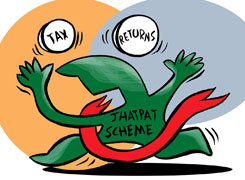Anil Rego | Answer |Ask -Follow
Financial Planner - Answered on Aug 25, 2021
He’s an expert in income tax and wealth management.
He has completed his CFA/MBA from the ICFAI Business School.... more

I have gone through your expert guide on Rediff.com. Kindly deliver your advice in my case as well. Thanks Sir.
I am a salaried class employee and filed ITR 1 for FY 2019-20 in Aug 2020. Inadvertently, I paid self-assessment tax twice through online (Rs 17,000 paid twice amounting total of Rs 34,000).
I wrote to the IT deparment for refund of the excess amount of Rs 17,000. The IT department advised me to file rectification online through my IT account. I tried in vain.
Kindly guide me in this regard.
You can claim refund in the revised ITR and provide necessary proofs that you paid excess tax (challan details and date of when both the self-assessment taxes were paid). If the claim holds good, a refund can be issued for the excess tax paid.
You may like to see similar questions and answers below
Mihir Tanna |1089 Answers |Ask -Follow
Tax Expert - Answered on Sep 29, 2022
Mihir Tanna |1089 Answers |Ask -Follow
Tax Expert - Answered on Nov 16, 2023
Sanjeev Govila | Answer |Ask -Follow
Financial Planner - Answered on Sep 20, 2023
T S Khurana |536 Answers |Ask -Follow
Tax Expert - Answered on Nov 26, 2024
Radheshyam Zanwar |6734 Answers |Ask -Follow
MHT-CET, IIT-JEE, NEET-UG Expert - Answered on Dec 06, 2025
Radheshyam Zanwar |6734 Answers |Ask -Follow
MHT-CET, IIT-JEE, NEET-UG Expert - Answered on Dec 06, 2025
Radheshyam Zanwar |6734 Answers |Ask -Follow
MHT-CET, IIT-JEE, NEET-UG Expert - Answered on Dec 06, 2025
Dr Dipankar Dutta |1837 Answers |Ask -Follow
Tech Careers and Skill Development Expert - Answered on Dec 05, 2025
Dr Shyam Jamalabad |108 Answers |Ask -Follow
Dentist - Answered on Dec 05, 2025
Dr Shyam Jamalabad |108 Answers |Ask -Follow
Dentist - Answered on Dec 05, 2025
Dr Shyam Jamalabad |108 Answers |Ask -Follow
Dentist - Answered on Dec 05, 2025
Dr Dipankar Dutta |1837 Answers |Ask -Follow
Tech Careers and Skill Development Expert - Answered on Dec 05, 2025
Ulhas Joshi |280 Answers |Ask -Follow
Mutual Fund Expert - Answered on Dec 05, 2025
Dr Dipankar Dutta |1837 Answers |Ask -Follow
Tech Careers and Skill Development Expert - Answered on Dec 04, 2025




























